
Ewenny Priory, in Ewenny in the Vale of Glamorgan, Wales, was a monastery of the Benedictine order, founded in the 12th century. The priory was unusual in having extensive military-style defences and in its state of preservation; the architectural historian John Newman described it as “the most complete and impressive Norman ecclesiastical building in Glamorgan”. Following the Dissolution of the Monasteries, parts of the priory were converted into a private house by Sir Edward Carne, a lawyer and diplomat. This Elizabethan house was demolished between 1803 and 1805 and replaced by a Georgian mansion, Ewenny Priory House. The house is still owned by the Turbervill family, descendants of Sir Edward. The priory is not open to the public apart from the Church of St Michael, the western part of the priory building, which continues to serve as the parish church for the village. The priory is in the care of Cadw and is a Grade I listed building.

Margam Castle, Margam, Port Talbot, Wales, is a late Georgian country house built for Christopher Rice Mansel Talbot. Designed by Thomas Hopper, the castle was constructed in a Tudor Revival style over a five-year period, from 1830 to 1835. The site had been occupied for some 4,000 years. A Grade I listed building, the castle is now in the care of Neath Port Talbot County Borough Council.

Christopher Rice Mansel Talbot FRS was a Welsh landowner, industrialist and Liberal politician. He developed his estate at Margam near Swansea as an extensive ironworks, served by railways and a port, which was renamed Port Talbot. He served as a Member of Parliament for Glamorgan constituencies from 1830 until his death in 1890, a sixty-year tenure which made him the second longest serving MP in the nineteenth century. He was Lord Lieutenant of Glamorgan, from 1848 to 1890.

Oxwich Castle is a Grade I listed castle which occupies a position on a wooded headland overlooking Oxwich Bay on the Gower Peninsula, Wales. Although it may occupy the site of an earlier fortification, it is a castle in name only as it is a grand Tudor fortified manor house built in courtyard style.

Margam Country Park is a country park estate in Wales, of around 850 acres (3.4 km²). It is situated in Margam, about 2 miles (3 km) from Port Talbot in south Wales. It was once owned by the Mansel Talbot family and is now owned and administered by the local council, Neath Port Talbot County Borough Council. Situated within the park are three notable buildings: Margam Abbey, a Cistercian monastery; Margam Castle, a neo-Gothic country house that was once the seat of the Mansel Talbot family; and the 18th-century Orangery. The park is designated Grade I on the Cadw/ICOMOS Register of Parks and Gardens of Special Historic Interest in Wales.
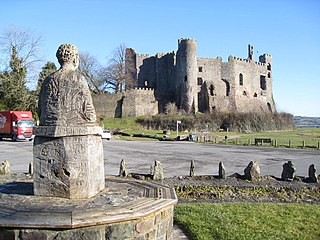
Laugharne Castle is in Laugharne, Carmarthenshire, Wales. The castle, located on the estuary of the River Tâf, was originally established in 1116. It was rebuilt as a Norman stronghold. There have been many alterations since then, including becoming a Tudor fortified manor house in the sixteenth century. It changed hands twice during the English Civil War, being eventually captured by Parliamentary forces in 1644.

Sketty Hall is a venue used for hosting social functions, business functions and conferences in Singleton Park, Swansea, south Wales. The original building was built in the early 18th century as a private house. Over the years it has seen a number of extensions, modifications and changes of use to its present-day role.

Hensol Castle is a castellated mansion in the Gothic Revival style dating from the late 17th century or early 18th century, now a wedding and conference venue for The Vale Resort. It is located north of Clawdd Coch and Tredodridge in the community of Pendoylan in the Vale of Glamorgan, Wales. It is a Grade I listed building and its park is designated Grade II on the Cadw/ICOMOS Register of Parks and Gardens of Special Historic Interest in Wales.

Old Beaupre Castle is a ruined medieval fortified manor house located in the community of Llanfair, outside Cowbridge in Wales. It is known in historic documents under the names Beawpire, Bewerpere, Bewpyr and Y Bewpur. It is a Grade I listed building and is under the care of Cadw. It can be visited free of charge all year round by members of the public. The gardens are designated Grade II on the Cadw/ICOMOS Register of Parks and Gardens of Special Historic Interest in Wales.
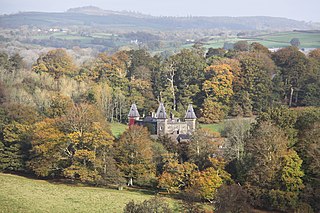
Dinefwr Park National Nature Reserve is an 800 acres (320 ha) estate about a mile from the centre of Llandeilo in Carmarthenshire owned by the National Trust, with a mansion in the centre. The highest point is occupied by the ruined Dinefwr Castle, ancient castle of the Deheubarth kingdom. It is a grade I Historic Park and a Site of Special Scientific Interest.
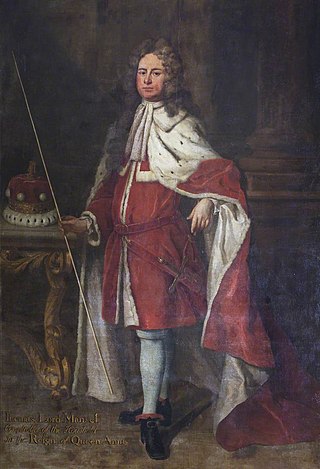
Thomas Mansel, 1st Baron Mansel PC was a Welsh nobleman and politician who sat in the English and British House of Commons from 1689 until 1712, when he was raised to the peerage as Baron Mansel as one of Harley's Dozen and sat in the House of Lords.
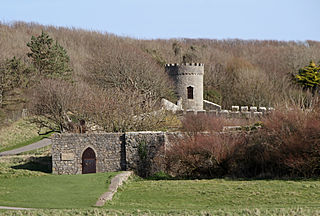
Dunraven Castle was a mansion on the South Wales coast near Southerndown. The existing manor house was rebuilt as a castellated hunting lodge in the early 19th century and was extensively remodelled later in the century. The surviving parts of the house are a Grade II listed building and its gardens and park are designated Grade II on the Cadw/ICOMOS Register of Parks and Gardens of Special Historic Interest in Wales.
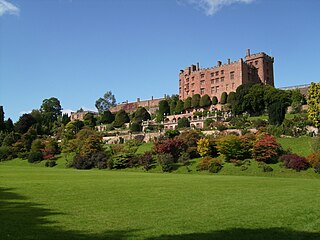
The Cadw/ICOMOS Register of Parks and Gardens of Special Historic Interest in Wales is a heritage register of significant historic parks and gardens in Wales. It is maintained by Cadw, the historic environment service of the Welsh Government and was given statutory status in 2022.

Castell Malgwyn is a grade II listed Georgian-style country house standing in a landscaped estate in the community of Manordeifi, Pembrokeshire, lying on the south bank of the river Teifi opposite the village of Llechryd. The gardens are listed at Grade II* on the Cadw/ICOMOS Register of Parks and Gardens of Special Historic Interest in Wales. The house is now an upmarket B&B.

Kilvrough Manor is a large country house near Swansea. It is a Grade II* listed building. Its park is listed on the Cadw/ICOMOS Register of Parks and Gardens of Special Historic Interest in Wales.
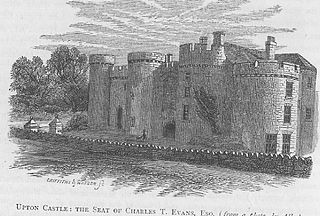
Upton Castle is a 13th-century castle or fortified manor house with an associated chapel, located near Cosheston, Pembrokeshire in Wales. Although in private ownership, the gardens are open to the public. They are listed on the Cadw/ICOMOS Register of Parks and Gardens of Special Historic Interest in Wales.

The war memorial at Port Talbot, Wales, commemorates local men killed in the First World War and Second World War. It is located in the Talbot Memorial Park, where it was erected in 1925; the names from the Second World War were added later. It was sculpted by Louis Frederick Roslyn, and was unveiled on 4 July 1925 by Sir William R. Robertson. The park in which it stands was donated to the town by Miss Emily Charlotte Talbot of Margam Castle, and opened to the public in 1926. The memorial has been Grade II* listed since the year 2000.

Llanmihangel Place is a Grade I listed manor house in the Vale of Glamorgan, South Wales. It became a Grade I listed building on 16 December 1952. The house dates back to the 12th century, when it was constructed as a single-storey dwelling.

The Church of St Andrew, Penrice, Swansea, Wales dates from the 12th century. A Grade II* listed building, St Andrew's remains an active parish church in the parish of South-West Gower, in the Diocese of Swansea and Brecon.

The City and County of Swansea is a principal area in south Wales. It covers an area of 380 km2 (150 sq mi) and in 2021 the population was approximately 237,800.




















